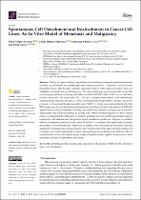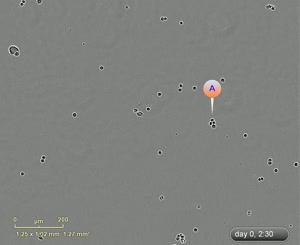| dc.contributor | Vall d'Hebron Barcelona Hospital Campus |
| dc.contributor.author | Vargas Accarino, Elena |
| dc.contributor.author | Herrera Montávez, Carlos |
| dc.contributor.author | Ramon y Cajal Agüeras, Santiago |
| dc.contributor.author | Aasen, Trond |
| dc.date.accessioned | 2022-01-24T13:33:13Z |
| dc.date.available | 2022-01-24T13:33:13Z |
| dc.date.issued | 2021-05 |
| dc.identifier.citation | Vargas-Accarino E, Herrera-Montávez C, Ramón y Cajal S, Aasen T. Spontaneous Cell Detachment and Reattachment in Cancer Cell Lines: An In Vitro Model of Metastasis and Malignancy. Int J Mol Sci. 2021 May;22(9):4929. |
| dc.identifier.issn | 1422-0067 |
| dc.identifier.uri | https://hdl.handle.net/11351/6874 |
| dc.description | Desprendimiento celular; Reinserción celular; Modelos de metástasis |
| dc.language.iso | eng |
| dc.publisher | MDPI |
| dc.relation.ispartofseries | International Journal of Molecular Sciences;22(9) |
| dc.rights | Attribution 4.0 International |
| dc.rights.uri | http://creativecommons.org/licenses/by/4.0/ |
| dc.source | Scientia |
| dc.subject | Regulació genètica |
| dc.subject | Metàstasi |
| dc.subject | Cèl·lules - Adherència |
| dc.subject.mesh | Gene Expression Regulation, Neoplastic |
| dc.subject.mesh | Neoplasm Metastasis |
| dc.subject.mesh | Cell Adhesion |
| dc.title | Spontaneous Cell Detachment and Reattachment in Cancer Cell Lines: An In Vitro Model of Metastasis and Malignancy |
| dc.type | info:eu-repo/semantics/article |
| dc.identifier.doi | 10.3390/ijms22094929 |
| dc.subject.decs | regulación de la expresión génica neoplásica |
| dc.subject.decs | metástasis neoplásica |
| dc.subject.decs | adhesión celular |
| dc.relation.publishversion | https://doi.org/10.3390/ijms22094929 |
| dc.type.version | info:eu-repo/semantics/publishedVersion |
| dc.audience | Professionals |
| dc.contributor.organismes | Institut Català de la Salut |
| dc.contributor.authoraffiliation | [Vargas-Accarino E, Herrera-Montávez C] Grup de Recerca en Patologia Molecular Translacional, Vall d’Hebron Institut de Recerca (VHIR), Barcelona, Spain. Vall d’Hebron Hospital Universitari, Barcelona, Spain. [Ramón Y Cajal S] Patologia Molecular Translacional, Vall d’Hebron Institut de Recerca (VHIR), Barcelona, Spain. Vall d’Hebron Hospital Universitari, Barcelona, Spain. Servei d’Anatomia Patològica, Vall d’Hebron Hospital Universitari, Barcelona, Spain. CIBER de Cáncer (CIBERONC), Instituto de Salud Carlos III, Avenida de Monforte de Lemos 3-5, 28029 Madrid, Spain. [Aasen T] Patologia Molecular Translacional, Vall d’Hebron Institut de Recerca (VHIR), Barcelona, Spain. Vall d’Hebron Hospital Universitari, Barcelona, Spain. CIBER de Cáncer (CIBERONC), Instituto de Salud Carlos III, Avenida de Monforte de Lemos 3-5, 28029 Madrid, Spain. Universitat Autònoma de Barcelona, Bellaterra, Spain |
| dc.identifier.pmid | 34066490 |
| dc.identifier.wos | 000650381000001 |
| dc.relation.projectid | info:eu-repo/grantAgreement/ES/PE2013-2016/CPII16%2F00042 |
| dc.rights.accessrights | info:eu-repo/semantics/openAccess |

 Área privada
Área privada Contacto
Contacto










